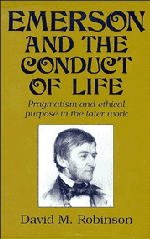Book contents
- Frontmatter
- Contents
- Acknowledgments
- List of Abbreviations
- Introduction
- 1 The Mystic and the Self-made Saint
- 2 Politics and Ecstasy
- 3 The Text of Experience
- 4 “Here or Nowhere”: Essays: Second Series
- 5 The Eclipse of the Hero: Representative Men
- 6 The Old and New Worlds: English Trait
- 7 “Work Is Victory”: The Conduct of Life
- 8 “Plain Living and High Thinking”: Society and Solitude
- 9 Toward a Grammar of the Moral Life
- Notes
- Work Cited
- Index
- Titles in the series
8 - “Plain Living and High Thinking”: Society and Solitude
Published online by Cambridge University Press: 18 December 2009
- Frontmatter
- Contents
- Acknowledgments
- List of Abbreviations
- Introduction
- 1 The Mystic and the Self-made Saint
- 2 Politics and Ecstasy
- 3 The Text of Experience
- 4 “Here or Nowhere”: Essays: Second Series
- 5 The Eclipse of the Hero: Representative Men
- 6 The Old and New Worlds: English Trait
- 7 “Work Is Victory”: The Conduct of Life
- 8 “Plain Living and High Thinking”: Society and Solitude
- 9 Toward a Grammar of the Moral Life
- Notes
- Work Cited
- Index
- Titles in the series
Summary
RUNNING FOR LUCK
“I fear the popular notion of success stands in direct opposition in all points to the real and wholesome success”
(W, 7:308).Although the publication of Society and Solitude came in 1870, a decade after that of The Conduct of Life, the two volumes are closely interconnected, originating in significant part from Emerson's lectures of the 1850s. An 1860 journal entry concerning the plans for The Conduct of Life (JMN, 14:346–7) suggests that the two books were conceived originally as a single work of two volumes, and the draft of the proposed contents shows a significant overlapping of the essays that were finally divided into the two books we now know. The distractions and difficulties of the years of the Civil War account in large part for the delay of publication of Society and Solitude. The book is thus connected more closely to Emerson's creative burst in the 1850s than its publication date might at first suggest.
The volume that followed in 1875, Letters and Social Aims, marked the beginning of the end of Emerson's creative career. His struggle to arrange lecture and journal material into a finished volume was punctuated by the fire at his home in 1872, which forced a long recuperative tour while the house was restored.
- Type
- Chapter
- Information
- Emerson and the Conduct of LifePragmatism and Ethical Purpose in the Later Work, pp. 159 - 180Publisher: Cambridge University PressPrint publication year: 1993



